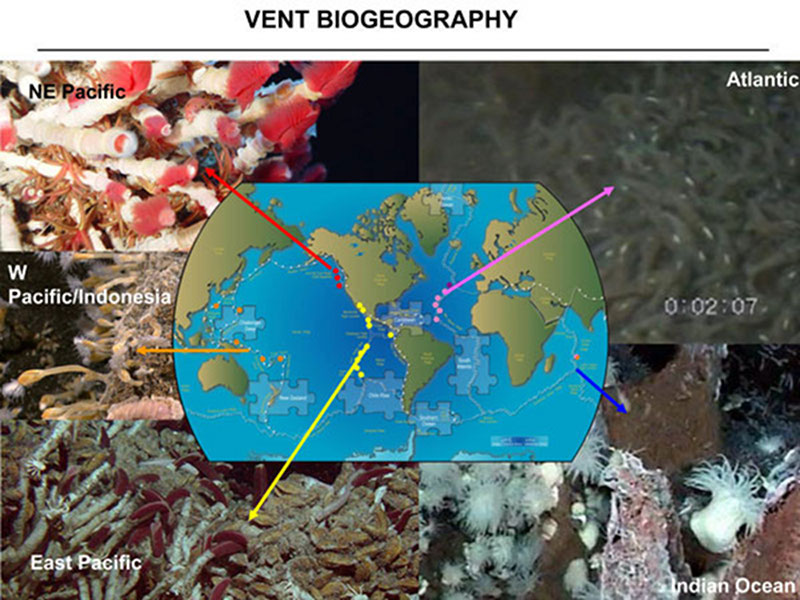
By Professor Paul Tyler, Faculty of Natural and Environmental Sciences - University of Southampton, UK
The discovery of hydrothermal vents along the Galapagos Rift in 1977 resulted in the description of a wonderful collection of animals, many previously unknown to science. Many of these species contained endosymbiotic bacteria that used hydrogen sulphide as an energy source to reduce carbon dioxide to organic matter, in a similar way to photosynthesis but in the absence of light. The dominant organisms were siboglinid tubeworms (then called vestimentiferans), large mussels, clams and limpet- like gastropods.
Not long afterwards hydrothermal vents were discovered in the Northeast Pacific along the Juan de Fuca Ridge. Tubeworms were again common but they were a different species as were the limpets, and the clams and mussels were absent. This was the first indication that different vents may have different collections of animals in different parts of the ocean.
Scientists then noticed a difference between the Northeast Pacific and the East Pacific—likely as a result of earth movements where the ridge had originally extended unbroken from the northeast corner of the Pacific down the whole eastern side of the Pacific. Over millions of years the ridge was broken by plate movements, which split it into segments in two main areas separated by the San Andreas Fault in between.

Hydrothermal vent biogeographic provinces in the global ocean. Yellow indicates the East Pacific vents dominated by the tubeworm Riftia, mussels and clams. Red indicates the NE Pacific vents dominated by the tubeworm Ridgeia. Orange represents the vents of the western Pacific that may be dominated by stalked barnacles or snails. Lilac are the Atlantic vents and there is still a discussion whether the deep and shallow vents are the same biogeographic province. Blue represents the Indian Ocean vents at the Rodriguez Triple Junction.
Image courtesy of:
By 1985 attention was being directed to the mid-ocean ridge in the Atlantic and the first discoveries of hydrothermal vents that were dominated by shrimp and anemones, but there was not a tubeworm in sight. Clams were also absent, but mussels were common at many of the sites as were the limpet-like gastropods. Since these discoveries, more sites have been found in the Atlantic without tubeworms and rarely with clams—although both have been found at cold seeps in the Atlantic. In the western Pacific the discovery of vents showed that they were dominated by snail-like gastropods and very recently vents in Indonesian waters were dominated by stalked barnacles. When vents were finally discovered in the Indian Ocean the most obvious fauna was anemones and shrimp, thus aligning them to the Atlantic but more detailed analysis showed that the smaller vent fauna in the Indian Ocean was related to the western Pacific.
The differences in the animals found in the different parts of the global ocean is called biogeography and as scientists we seek to explain these differences in terms of oceanographic, geological and biological reasons—using the clues to understand why marine species live where they do. Oceanographic reasons may be that water movements do not connect two regions of the oceans. This is seen by comparing the Pacific and the Atlantic—only connected by the Drake Passage between southern Chile and Antarctica. Geological reasons may be that two segments of mid-ocean ridge are not continuous as described for the eastern Pacific. The last reason is biological. Animals disperse by having a life cycle stage that drifts in the water column. How far this disperses depends on the length of the larval life and the strength of the prevailing current. If the larva can be transported far enough it may eventually settle to form a new colony and possibly a new biogeographic region or extend one already known.
Our knowledge of the distribution of animals at hydrothermal vents has increased significantly over the last 34 years, but it is necessary to find new vent sites in unexplored areas to see if the animals present conform to known biogeographic provinces or form entirely new ones. This is what we are doing by exploring the Cayman Trough.